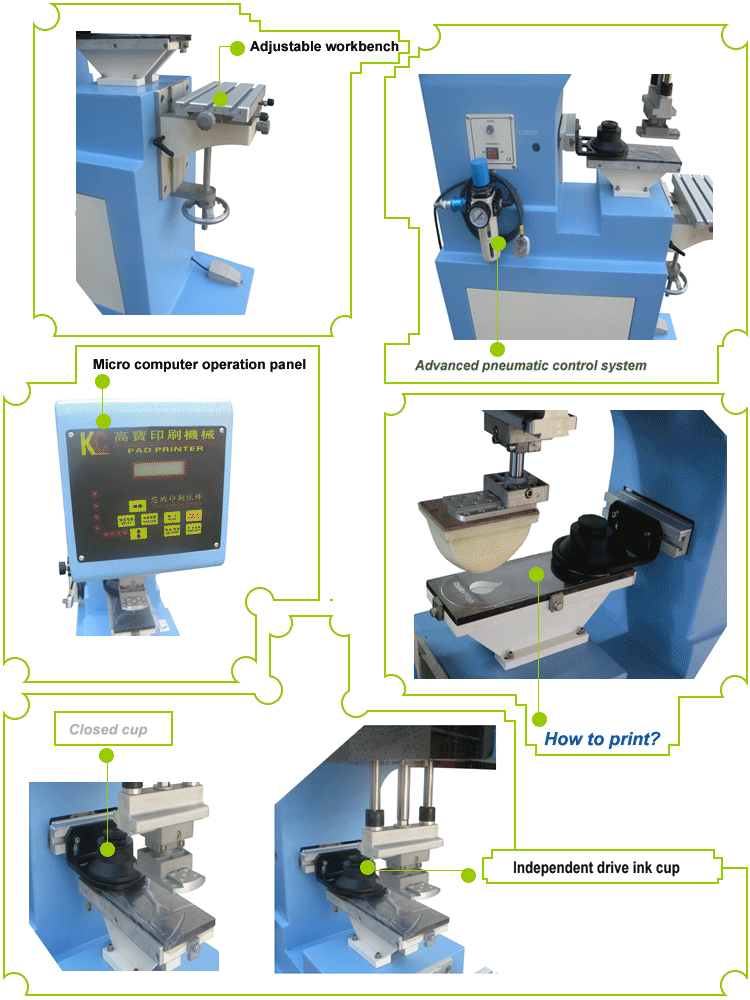Model No.︰PM1-100T
Brand Name︰LC
Country of Origin︰China
Unit Price︰US $ 1573 / pc
Minimum Order︰1 pc
Daily necessities monochrome ink cup pad printer:
Working principle
It mainly uses the rubber head to dip the ink in the oil cup, and then transfers the ink to the surface of daily necessities. The rubber head will first press down to contact the ink in the oil cup, absorb an appropriate amount of ink, and then move to the top of the object to be printed, accurately printing the ink on the corresponding position on its surface to achieve the printing of patterns or text.
Features and advantages
• Strong applicability: It can handle daily necessities of different shapes and materials such as soap boxes and tissue boxes. For example, soap boxes are made of plastic, paper and other materials, and tape measures have metal shells. Pad printers can print on their surfaces. Just adjust the relevant parameters according to the characteristics of the items.
• Accurate ink control: The design of the oil cup can better control the amount of ink, avoiding excessive ink causing blurred patterns and ink seepage, or too little ink causing unclear printing and lack of color. When printing delicate patterns on small items such as key chains, accurate ink control is particularly important to ensure printing quality.
• High printing accuracy: With the help of advanced positioning systems, patterns and texts can be accurately printed at designated locations, meeting the accuracy requirements of printed content such as brand logos and functional descriptions for daily necessities. For example, when printing brand trademarks and operating instructions on fan housings, pad printers can ensure that their positions are accurate, clear and beautiful.
• Easy operation: Usually the operation interface is simple and easy to understand, and operators can get started after simple training. In addition, the debugging and maintenance of the equipment are relatively uncomplicated, which is suitable for the printing needs of small and medium-sized enterprises or small-batch production of daily necessities.
Application scenarios
It is widely used in daily necessities manufacturers, such as printing brand names and patterns on tissue boxes to enhance the beauty and recognition of products; printing scale marks and brand trademarks on tape measures to facilitate product use and brand promotion; printing personalized patterns and text on key chains to increase the fun and attractiveness of products, etc.
|
One color pad printer //Structure |
|
|
Working table |
Standard working table with 3-size adjustment |
|
Ink supply system |
Closed -type system |
|
Plate type |
10mm Thick steel plate. |
|
Pad dropping control |
Simple-cylinder , simultaneously pressing |
|
One color pad printer//Usage and characters |
|
|
Guide |
|
|
Application fields |
Electrons, hardware, autos, toys, gifts, Plastics, household appliances, artwork, stationery, adornment, cosmetic, commodity, sport goods, decorative lightings, woodwork, office supplies, Photo Materials, Kitchen utensils, Hotel supplies, Computer, Mobile, etc., industrial field. |
|
One color pad printer //Parameter |
|
|
Technical parameters |
PM1-100T |
|
|
| PM1-150T | |
|
|
| PM1-200T | |
|
|
|
Works supply |
|
|
Package list |
|
|
H.S.Code |
8443198000 |
|
Certicate |
CE |
|
One color pad printer //Advantage |
|
|
Function |
|
Printing supplies︰
Pad printers target a wide variety of products, with differences in shape and material. Different products have different printing positions and printing effects. Printing engineers must design different printing processes and select different printing consumables according to user needs.
1) Pad printing plates: The plates are made of thick steel plates, thin steel sheets, resin plates, etc. They are used on oil cup pad printers or open pad printers. The printed pattern needs to be etched on the plates. Generally, a single-color pad printer is equipped with one plate, a two-color pad printer is equipped with two plates, and so on.
2) Fixture: The printed product must be fixed on the workbench with a fixture to ensure that the printing position meets the requirements. The fixture can be made of metal or non-metal materials. A single-color pad printer and a shuttle pad printer require a fixture, while a turntable pad printer needs to be equipped with a number of fixtures equal to the number of workstations.
3) Ink: The ink type is selected according to the material of the product, and the ink color is selected according to the printed pattern. Different types of inks should match different pad printing processes. After the ink dries, it should be able to firmly adhere to the product surface. A single-color pad printer uses one color of ink at a time, a four-color pad printer uses four colors of ink, and so on.
4) Pad printing rubber head: Different product shapes and different pad printing patterns require pad printing rubber heads of different shapes. The pad printing rubber head should be able to perfectly achieve the pad printing task and maintain the stability of the properties.
5) Blade or oil cup: Blades are used on open pad printing machines, and oil cups are used on closed pad printing machines. Blades and oil cups should be able to scrape off the ink on the steel plate and should be replaced in time when damaged.






